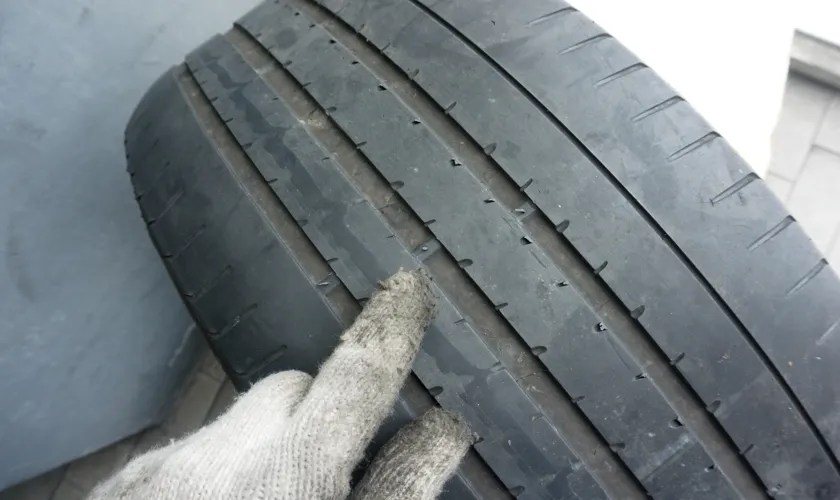Have you ever seen those little rubber bumps that run across your tire’s tread pattern and wondered what they are for? These bumps are known as wear bars, and they play an essential role in maintaining your vehicle’s safety. Understanding the wear bar on your tires is crucial to ensure that you replace them at the right time and keep your vehicle running smoothly on the roads. It’s easy to overlook the wear bars, but they are designed to help you stay informed about when it’s time to get your tires replaced.
In this blog post, we will explore what the wear bar on tires is and why it matters. So, grab a cup of coffee, get comfortable, and let’s dive in!
Table of Contents
What is a Wear Bar?
If you’re wondering what that thin strip of rubber that runs perpendicular to the tire tread is, it’s called a wear bar. The wear bar is designed to indicate when a tire has reached its limit and needs to be replaced. Over time, the tire tread wears down, reducing its ability to grip the road and creating a hazard for drivers.
The wear bar is typically located in a few spots around the tire, and when it becomes flush with the tread, it’s a sign that the tire has reached the minimum allowable tread depth and needs to be replaced. So, if you’re always wondering how much life your tires have left, just keep an eye on the wear bar. It’s a simple and effective way to ensure that your tires are safe and working at optimal performance.
A small raised bump on the tire that shows when the tread depth is low.
A wear bar is a small raised bump on a tire that acts as an indicator for when the tread depth has become too low. This is important because the tread depth is what allows the tire to maintain proper contact with the road, providing safety and optimal performance. The wear bar is typically located inside the tire’s tread grooves and serves as a warning to drivers that it’s time to replace their tires.
This small bump is specifically designed to be visible when the tread depth has worn down to a certain point, usually indicating around 2/32 ” of remaining depth. Driving on tires without proper tread depth can be dangerous, especially during wet or snowy conditions and can lead to losing control of the vehicle. Always remember to check your tire’s wear bar for visibility and have them replaced as soon as the wear indicators become visible.

Why is it Important?
So, you’ve probably seen the small raised bars on your tire and said to yourself, “what is the wear bar on a tire?” These bars are actually called wear indicators, and they’re important because they tell you when your tire needs to be replaced. The wear indicators are located in the grooves of the tire and are designed to show when the tire has lost too much tread. If the tread has worn down to the level of the indicators, it’s time for a new tire.
Driving on tires with low tread can be dangerous, as they can’t grip the road properly, especially in wet or slippery conditions, which increases the risk of accidents. So, keep an eye on those wear indicators and make sure to replace your tires when necessary.
Indicates when the tire should be replaced to ensure safe driving.
As a driver, it’s essential to understand when to replace your tires. Not only is it crucial for the safety of yourself and your passengers, but it can also prevent accidents on the road. Over time, tires will wear down and lose their traction, which can increase braking distance and decrease stability on the road.
This is why tire manufacturers recommend replacing your tires every six years, regardless of how much you’ve driven them. However, if you notice any signs of wear and tear, such as cracking or bulging, it’s essential to replace them immediately. Don’t forget that your tires are the only things keeping your vehicle connected to the road, so it’s crucial to ensure they’re in good condition.
By replacing your tires regularly, you can maintain optimal performance, improve fuel efficiency, save money on repairs, and most importantly, keep yourself and others safe on the road.
How to Find the Wear Bars?
Have you ever heard of the wear bar on a tire? If not, don’t worry, you’re not alone. The wear bar is a small, raised feature located inside the tire’s tread grooves that indicates the tire’s wear limit. It’s designed to let you know when it’s time to replace your tires to prevent accidents caused by worn-out tires.
To locate the wear bar, simply look for raised bumps or bars between the treads of your tires. If the remaining tread depth is level with the wear bar, it’s an indication that the tire is due for replacement. Don’t ignore the wear bar, as driving on worn-out tires can lead to a decrease in traction, making your vehicle more vulnerable to hydroplaning, skidding, and losing control.
Regularly checking the wear bar can help you ensure that your tires are always in good condition, keeping you safe on the road.
Look for a small bump or triangle symbol on the sidewall of the tire.
Finding the wear bars on your tires is crucial for the safety of you and your vehicle. These bars indicate that your tires have reached a point where they need to be replaced. To locate them, look for a small bump or triangle symbol on the sidewall of the tire.
This symbol indicates where the wear bars are located, usually between the treads of the tire. Once you find the symbol, run your fingers across the tire and feel for a slight bump that is flush with the grooves. This is the wear bar! It’s essential to replace your tires when you reach this point because driving on worn tires can lead to decreased traction, longer stopping distances, and potentially dangerous accidents.
So, if you’ve noticed decreased performance or handling in your vehicle, including issues with braking or accelerating, it may be time to check your wear bars and replace your tires. Stay safe on the road by keeping an eye on your tire wear and replacing them as necessary.
When to Replace Tires?
If you’re wondering when to replace your tires, the wear bar on a tire can help you determine if it’s time to make a change. A wear bar is a small strip of rubber molded across the tire’s tread pattern. As the tire wears down over time, this strip becomes more visible.
When the wear bar is level with the tire tread, it is time to replace the tire. Driving on tires with little tread depth can pose a serious safety hazard, as it reduces your vehicle’s ability to grip the road, especially in wet or icy conditions. It’s also important to remember that even if your tires have plenty of tread, they should still be replaced every 6 years, as the rubber can deteriorate over time.
Be sure to give your tires a visual inspection regularly to check for any damage or signs of wear, and consult a professional if you’re unsure about their condition.
When the wear bars are exposed or the tread depth is less than 2/32 of an inch.
As a responsible driver, it is essential to keep an eye on the condition of your tires to ensure your safety on the road. Knowing when to replace your tires can be a little confusing, but there are sure signs that indicate it’s time to change them. The easiest way to determine the tire’s condition is by checking the tread depth.
The tread is the rubber on the outermost part of a tire that comes into contact with the road. When the tread wears down, it can affect the tires’ ability to grip the road properly, particularly in wet conditions, increasing the risk of accidents. Therefore, if the depth is less than 2/32 of an inch or the wear bars are exposed, it’s time to replace them.
You can also look out for signs of damage, such as cracks, bulges, or punctures, which can cause leaks or blowouts. Don’t wait until it’s too late to replace your tires, as it can lead to hazardous situations on the road. So, keep an eye on your tires’ condition, and if you notice any of these signs, get them replaced immediately to maintain your safety and ensure that you have a pleasant driving experience.
Conclusion
In short, the wear bar on a tire is like a warning signal from your car’s wheels, telling you that it’s time to treat your tires to some new threads. You wouldn’t want to wear your shoes down to the bare soles, unless you’re trying to channel your inner beach bum, and the same goes for your rubber road warriors. So, when you see those snazzy little bars peeking out from between your tire treads, take it as a sign that it’s time to give your car’s feet a little TLC.
“
Wear bars are a simple but crucial indicator of tire safety and should be checked regularly.
Wear bars are a vital component of tire safety, as they indicate when it’s time to replace your tires. These small raised bars located in the grooves of your tire act as a visual cue for tire wear. As you drive, the rubber on your tires slowly wears down, and when this process reaches a certain point, the wear bars will become visible.
The wear bars can be identified by a small mark on the sidewall of your tire, indicating the location of these bars. It’s important to inspect these bars regularly to ensure that your tires are still in good condition. When the wear bars become visible, it’s a sign that it’s time for a new set of tires.
Ignoring this signal can be dangerous, as worn-out tires can cause accidents, especially on wet or slippery roads. Replacing your tires when the wear bars are visible is critical to your safety and the safety of others on the road. It’s always better to be safe than sorry, so don’t wait until it’s too late to replace your tires.
Remember, wear bars are a simple but crucial tool to monitor your tire condition and avoid potential danger on the road.
FAQs
1. What is a wear bar on a tire?
A wear bar is a small raised bar or ridge that appears across the tire’s tread indicating that the tread is wearing down and the tire has reached its legal limit and needs replacement.
2. Why is it important to check the wear bar on a tire?
It is important to check the wear bar on a tire because it indicates whether the tire is safe to use or not. If the wear bar is visible, it means that the tire has worn down to its minimum tread depth and is no longer safe to use.
3. How do you check the wear bar on a tire?
To check the wear bar on a tire, examine the tread pattern and look for a small raised bar or ridge running perpendicular to the tread. If the tread has worn down to the level of the wear bar or if it is visible, it indicates that the tire is worn out and needs replacing.
4. What is the legal minimum tread depth for tires?
The legal minimum tread depth for tires varies by state, but in general, it is 2/32 inch (1.6 millimeters). Tires with less than the minimum tread depth are considered unsafe and need to be replaced.
5. How often should you check the wear bar on your tires?
You should check the wear bar on your tires at least once a month, or before taking a long trip. It is also recommended to have your tires checked by a professional at least once a year.
6. Can you increase the lifespan of your tires by checking the wear bar regularly?
Yes, checking the wear bar on your tires regularly can increase the lifespan of your tires. By replacing worn-out tires before they become unsafe, you can avoid blowouts and other accidents that could damage your vehicle or put you and other drivers at risk.
7. What should you do if the wear bar on your tire is visible?
If the wear bar on your tire is visible, you should immediately replace the tire. Continuing to drive on worn-out tires can be dangerous, as it decreases traction and increases the risk of blowouts and accidents.



